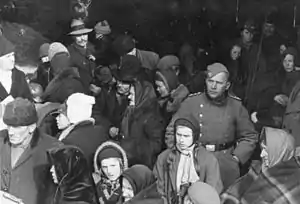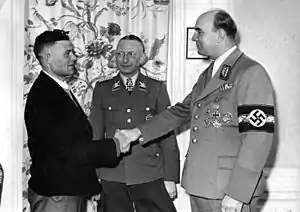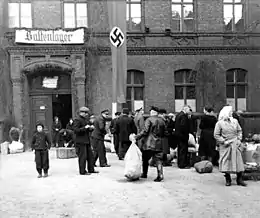Heim ins Reich
The Heim ins Reich (German pronunciation: [ˈhaɪm ʔɪns ˈʁaɪç] (![]() listen); meaning "back home to the Reich") was a foreign policy pursued by Adolf Hitler during World War II, beginning in 1938. The aim of Hitler's initiative was to convince all Volksdeutsche (ethnic Germans) who were living outside Nazi Germany (e.g. in Austria, Czechoslovakia and the western districts of Poland) that they should strive to bring these regions "home" into Greater Germany, but also relocate from territories that were not under German control, following the conquest of Poland in accordance with the Nazi-Soviet pact.[2] The Heim ins Reich manifesto targeted areas ceded in Versailles to the newly reborn nation of Poland, various lands of immigration as well as other areas that were inhabited by significant German populations such as the Sudetenland, Danzig (now Gdansk}, and the southeastern and northeastern regions of Europe after 6 October 1939.
listen); meaning "back home to the Reich") was a foreign policy pursued by Adolf Hitler during World War II, beginning in 1938. The aim of Hitler's initiative was to convince all Volksdeutsche (ethnic Germans) who were living outside Nazi Germany (e.g. in Austria, Czechoslovakia and the western districts of Poland) that they should strive to bring these regions "home" into Greater Germany, but also relocate from territories that were not under German control, following the conquest of Poland in accordance with the Nazi-Soviet pact.[2] The Heim ins Reich manifesto targeted areas ceded in Versailles to the newly reborn nation of Poland, various lands of immigration as well as other areas that were inhabited by significant German populations such as the Sudetenland, Danzig (now Gdansk}, and the southeastern and northeastern regions of Europe after 6 October 1939.
| home to the Reich | |
 The Third Reich in 1939 (dark grey) after the conquest of Poland; with pockets of German colonists brought into the annexed territories of Poland from the Soviet "sphere of influence". – Nazi propaganda poster superimposed with the red outline of Poland missing entirely from the original print.[1] | |
| Duration | 1938–1944 |
|---|---|
| Location | Territories controlled by Nazi Germany |
| Type | Ethnic cleansing and population transfer |
| Cause | Lebensraum, Generalplan Ost |
| Patron(s) | Adolf Hitler |
Implementation of the policy was managed by VOMI (Hauptamt Volksdeutsche Mittelstelle or "Main Welfare Office for Ethnic Germans"). As a state agency of the NSDAP, it handled all Volksdeutsche issues. By 1941, the VOMI was under the control of the SS.[3]
History
The end of World War I in Europe led to the emergence of the new ‘minority problems’ in the areas of collapsing German and Austro-Hungarian empires. Over 9 million ethnic Germans found themselves living in Poland, Czechoslovakia, Romania, and Yugoslavia; as a result of the Paris Peace Conference, 1919.[2] Unlike the new sovereign states, Germany was not required to sign the Minority Treaties.[4] Prior to the Anschluss, a powerful radio transmitter in Munich bombarded Austria with propaganda of what Hitler had already done for Germany, and what he could do for his native home country Austria.[5] The annexation of Austria was presented by the press as the march of the German armed forces into purported German land: "as representatives of a general German will to unity, to establish brotherhood with the German people and soldiers there."[6] In a similar manner, the 1939 German ultimatum to Lithuania leading to the annexation of Memel from the Republic has been glorified as Hitler's "latest stage in the progress of history."[7]
After the Anschluss with Austria, the "Back home to the Reich" slogan became popular among Sudeten Germans. During the Czech crisis, Hitler visited the German Gymnastics and Sports Festival in Breslau, and when the Sudeten team passed the VIP stand where Hitler was, they did so shouting "Back home to the Reich!" Josef Goebbels noted in his diary that "The people yelled, cheered and cried. The Führer [Hitler] was deeply moved."[8]
Concurrent with annexations were the beginnings of attempts to ethnically cleanse non-Germans both from Germany and from the areas intended to be part of a "Greater Germany". Alternately, Hitler also made attempts to Germanize those who were considered ethnically or racially close enough to Germans to be "worth keeping" as part of a future German nation, such as the population of Luxembourg. Germany officially considered these populations to be German, but not part of the Greater German Reich, and were thus the targets of propaganda promoting this view in order to integrate them. These attempts were largely unpopular with the targets of the Germanization, and the citizens of Luxembourg voted in a 1941 referendum up to 97% against becoming citizens of Nazi Germany.[9]
Propaganda was also directed to Germans outside Nazi Germany to return as regions, or as individuals from other regions. Hitler hoped to make full use of the "German Diaspora."[10] As part of an effort to lure ethnic Germans back to Germany,[11] folksy Heimatbriefe or "letters from the homeland" were sent to German immigrants to the United States.[12] The reaction to these was on the whole negative, particularly as they picked up.[13] Goebbels also hoped to use German-Americans to keep America neutral during the war, but this actually produced great hostility to Nazi propagandists.[14] Newspapers in occupied Ukraine printed articles about antecedents of German rule over Ukraine, such as Catherine the Great and the Goths.[15]
Heim ins Reich in Nazi terminology and propaganda also referred to former territories of the Holy Roman Empire. Joseph Goebbels described in his diary that Belgium and the Netherlands were subject to Heim im Reich policy in 1940. Belgium was supposedly lost to France by the Austrian Empire in 1794. The policy for German expansion was planned as part of Generalplan Ost to continue further eastwards into Poland, the Baltic states and the Soviet Union, thus creating a Greater Germany from the North Sea to the Urals.[16]
"Heim ins Reich" in occupied Poland 1939–1944



The same motto (Heim ins Reich ) was also applied to a second, closely related policy initiative which entailed the uprooting and relocation of ethnically German communities (Volksdeutsche ) from Central and Eastern European countries in the Soviet "sphere of influence", which settled there during the Ostsiedlung of earlier centuries. The Nazi government determined which of these communities were not "viable", started propaganda among the local population, and then made arrangements and organized their transport. The use of scare tactics about the Soviet Union led to tens of thousands leaving.[1] This included Germans from Bukovina, Bessarabia, Dobruja and Yugoslavia. For example, after the Soviets had assumed control of this territory, about 45,000 ethnic Germans had left Northern Bukovina by November 1940.[17] (Stalin permitted this out of fear they would be loyal to Germany.)[18]
| Territory of origin | Year | Number of resettled Volksdeutsche |
|---|---|---|
| South Tyrol (see South Tyrol Option Agreement) | 1939–1940 | 83,000 |
| Latvia and Estonia | 1939–1941 | 69,000 |
| Lithuania | 1941 | 54,000 |
| Volhynia, Galicia, Nerewdeutschland | 1939–1940 | 128,000 |
| General Government | 1940 | 33,000 |
| North Bukovina and Bessarabia | 1940 | 137,000 |
| Romania (South Bukovina and North Dobruja) | 1940 | 77,000 |
| Yugoslavia | 1941–1942 | 36,000 |
| USSR (pre-1939 borders) | 1939–1944 | 250,000 |
| Summary | 1939–1944 | 867,000 |
In the Greater Poland (Wielkopolska ) region (joined together with the Łódź district and dubbed "Wartheland" by the Germans), the Nazis' goal was the complete "Germanization", or political, cultural, social, and economic assimilation of the territory into the German Reich. In pursuit of this goal, the installed bureaucracy renamed streets and cities and seized tens of thousands of Polish enterprises, from large industrial firms to small shops, without payment to the owners. This area incorporated 350,000 such "ethnic Germans" and 1.7 million Poles deemed Germanizable, including between one and two hundred thousand children who had been taken from their parents (plus about 400,000 German settlers from the "Old Reich").[20] They were housed in farms left vacant by expulsion of the local Poles.[21] Militant party members were sent to teach them to be "true Germans".[22] Hitler Youth and League of German Girls sent young people for "Eastern Service", which entailed (particularly for the girls) assisting in Germanization efforts.[23] They were harassed by Polish partisans (Armia Krajowa) during the war. As Nazi Germany lost the war, they were expelled to remaining Germany.


Eberhardt cites estimates for the ethnic German influx provided by Szobak, Łuczak, and a collective report, ranging from 404,612 (Szobak) to 631,500 (Łuczak).[24] Anna Bramwell says 591,000 ethnic Germans moved into the annexed territories, and details the areas of colonists' origin as follows: 93,000 were from Bessarabia, 21,000 from Dobruja, 98,000 from Bukovina, 68,000 from Volhynia, 58,000 from Galicia, 130,000 from the Baltic states, 38,000 from eastern Poland, 72,000 from the Sudetenland, and 13,000 from Slovenia.[25] During "Heim ins Reich" Germans were settled in the homes of expelled Poles.
Additionally some 400,000 German officials, technical staff, and clerks were sent to those areas in order to administer them, according to "Atlas Ziem Polski" citing a joint Polish–German scholarly publication on the aspect of population changes during the war[26] Eberhardt estimates that the total influx from the Altreich was about 500,000 people.[27] Duiker and Spielvogel note that up to two million Germans had been settled in pre-war Poland by 1942.[28] Eberhardt gives a total of two million Germans present in the area of all pre-war Poland by the end of the war, 1.3 million of whom moved in during the war, adding to a pre-war population of 700,000.[27]
| Territory (region) | Number of German colonists |
|---|---|
| Warthegau | 536,951 |
| Reichsgau Danzig-West Prussia | 50,204 |
| East Upper Silesia | 36,870 |
| Regierungsbezirk Zichenau | 7,460 |
| Piotr Eberhardt. Political Migrations in Poland, 1939–1948. Warsaw. 2006.[29] | |
The increase of German population was most visible in the urban centres: in Poznań, the German population increased from ~6,000 in 1939 to 93,589 in 1944; in Łódź, from ~60,000 to 140,721; and in Inowrocław, from 956 to 10,713.[30] In Warthegau, where most Germans were settled, the share of the German population increased from 6.6% in 1939 to 21.2% in 1943.[31]
See also
References
Notes
- Nicholas 2011, pp. 207–209.
- Lynn M. Tesser. "Europe´s pivotal peace projects: Ethnic separation and European integration" (PDF). March 2015 Issue 6. European Policy Analysis. Archived from the original (PDF) on 13 January 2017. Retrieved 11 January 2017.
Heim ins Reich, with approximately 600,000 Germans (Volksdeutsche) moving into designated areas [was approved by Hitler, in] a bevy of population exchange agreements in 1938-40 [including] in a 6 October 1939 Reichstag speech.
Cite journal requires|journal=(help) - R. M. Douglas (2012). Orderly and Humane: The Expulsion of the Germans after the Second World War. Yale University Press. p. 21. ISBN 978-0300183764.
In a keynote address to the Reichstag to mark the end of the 'Polish campaign', Hitler announced on October 6, 1939 ... the Heim ins Reich (Back to the Reich) program. The prospect horrified many ethnic Germans, much of whose enthusiasm for Nazism had been predicated on the expectation that the boundaries of the Reich would, as in the cases of Austria, the Sudetenland, and Danzig, extend to embrace them. The prospect of being uprooted from their homes to face an uncertain future not even in Germany proper, but in the considerably less salubrious environment of western Poland, was much less attractive. So far from rallying enthusiastically to the Führer's call, therefore, many Volksdeutsche greeted the declaration of the Heim in Reich initiative with a deep sense of betrayal.
- Alan Sharp (2008). The Versailles Settlement: Peacemaking After the First World War, 1919-1923. Palgrave Macmillan. pp. 111, 127, 158. ISBN 978-1137069689 – via Google Books.
- Anthony Rhodes (1976), Propaganda: The art of persuasion: World War II, Chelsea House Publishers, New York, p. 27.
- Randall Bytwerk (1998), "Marching into Austria." Die Wehrmacht biweekly reporting on 12 March 1938. German propaganda archive. Calvin College.
- Eugen Hadamovsky (1939), World History on the March. The last chapter, pp. 342-350: "Memel District is Free!" German propaganda archive. Calvin College.
- Ullrich, Volker (2017) Hitler: Ascent: 1889-1939. Translated by Jefferson Chase. New York: Vintage. p.731. ISBN 978-1-101-87205-5
- Paul Dostert, Luxemburg unter deutscher Besatzung 1940-45. Zug der Erinnerung 2015.
- Lynn H. Nicholas (2011), Cruel World: The Children of Europe in the Nazi Web. Knopf Doubleday Publishing Group, p. 194. ISBN 0307793826 – via Google Books.
- Nicholas 2011, p. 195.
- Nicholas 2011, p. 197.
- Nicholas 2011, p. 199.
- Rhodes, p. 147.
- Karel C. Berkhoff, Harvest of Despair: Life and Death in Ukraine Under Nazi Rule, p. 192. ISBN 0-674-01313-1
- Eddy de Bruyne, Marc Rikmenspoel, For Rex and for Belgium: Léon Degrelle and Walloon Political & Military Collaboration 1940-45. Helion, 2004, pp. 71-80, ISBN 1874622329.
- Leonid Ryaboshapko. Pravove stanovishche nationalinyh mensyn v Ukraini (1917–2000), p. 259. (in Ukrainian)
- Nicholas 2011, p. 204.
- Enzyklopadie Migration in Europa. Vom 17. Jahrhundert bis zur Gegenwart. München: K.J. Bade, 2007, pp. 1082–1083.
- Pierre Aycoberry, The Social History of the Third Reich, 1933–1945. p. 228. ISBN 1565845498
- Nicholas 2011, pp. 213–214
- Aycoberry, p. 255.
- Nicholas 2011, p. 215.
- Piotr Eberhardt, Political Migrations in Poland, 1939–1948. Warsaw 2006. p. 24. "Archived copy" (PDF). Archived from the original (PDF) on 2011-10-18. Retrieved 2016-02-08.CS1 maint: archived copy as title (link)
- Anna Bramwell citing the ILO study, Refugees in the age of total war. Routledge. 1988. p. 123. ISBN 0044451946
- Wysiedlenia, wypędzenia i ucieczki 1939–1959: atlas ziem Polski: Polacy, Żydzi, Niemcy, Ukraińcy. Warszawa Demart 2008
- Eberhardt, p. 22.
- William J. Duiker, Jackson J. Spielvogel, World History, 1997: By 1942, two million ethnic Germans had been settled in Poland. p. 794.
- Eberhardt. p. 25.
- Eberhardt. p. 26. Eberhardt refers to Polska Zachodnia... 1961. p. 294.
- Eberhardt. p. 26.
Further reading
- Koehl, R. L. (1957). RKFDV: German Resettlement and Population Policy 1939–1945. Cambridge Massachusetts: Harvard University Press.
- Komjathy, Anthony and Stockwell, Rebecca (1980). German Minorities and the Third Reich: Ethnic Germans of East Central Europe between the Wars London: Holmes & Meier ISBN 9780841905405
- Lumans, Valdis O. (1993). Himmler's Auxiliaries: The Volksdeutsche Mittelstelle and the German National Minorities of Europe, 1933-1945. Chapel Hill, North Carolina: University of North Carolina Press ISBN 9780807820667
- Obermair, Hannes (2020). „Großdeutschland ruft!“ Südtiroler NS-Optionspropaganda und völkische Sozialisation – “La Grande Germania chiamaǃ” La propaganda nazionalsocialista sulle Opzioni in Alto Adige e la socializzazione ‘völkisch’ (in German and Italian). Tyrol Castle: South Tyrolean Museum of History. ISBN 978-88-95523-35-4.
External links
 Media related to Resettlement of Volksdeutsche at Wikimedia Commons
Media related to Resettlement of Volksdeutsche at Wikimedia Commons